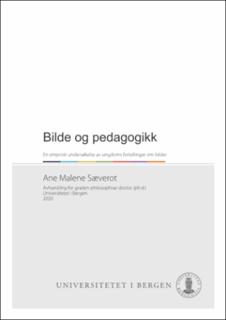| dc.contributor.author | Sæverot, Ane Malene | |
| dc.date.accessioned | 2020-06-09T09:04:40Z | |
| dc.date.available | 2020-06-09T09:04:40Z | |
| dc.date.issued | 2020-06-12 | |
| dc.date.submitted | 2020-05-27T15:17:28.151Z | |
| dc.identifier | container/5a/39/a9/7a/5a39a97a-e3a8-4954-a375-426d9275aa21 | |
| dc.identifier.isbn | 9788230866993 | |
| dc.identifier.isbn | 9788230848852 | |
| dc.identifier.uri | https://hdl.handle.net/1956/22512 | |
| dc.description.abstract | The topic of this dissertation is images, youths and pedagogy. The life of youths today is characterized by digital media and technological objects, such as smartphone, IPAD and computer (Frantzen and Schofield, 2018, Tønnessen, 2007). Many young people are online and available most of the day on social media, such as Snapchat, Facebook and Instagram. Both communication and dissemination of knowledge are often visual and figurative (Bamford, 2006; 2012). We may assume that most young people are surrounded by thousands of images daily. Literature review shows that there is a lot of research on visual culture, social media and youths (Frantzen and Schofield, 2018). Nevertheless, the connection between images and youths has only been explored to a small degree (Skarpenes and Saeverot, 2018). This is one of the reasons why the main theme of this dissertation is educational implications of the significance of images for youths. The purpose of the dissertation is to understand and at the same time develop knowledge of how young people live with and use images in a world that is distinctly visual. The objective is thus to generate new knowledge about, and create a greater awareness of, the use of images by way of teaching. The overall problem of the thesis reads thus: How may we understand youths’ narratives, response to and use of images? This problem is explored in more detail through three perspectives in the three articles of the thesis: 1) What significance can images have for young people’s understanding of their existence in the world, and how may images make room for ethical and existential reflections? 2) What do school students report as important in their lives and how should we understand the pattern that emerges? 3) How may teachers make use of images in the teaching of students in upper secondary school? The empirical data material on which the articles are based is collected by means of semistructured interviews. The interviews were threefolded and had different approaches to the usage and understandings of images. It has been a fundamental idea that the dissertation should have an approach that was characterized by epistemic symmetry (see Sæverot and Skarpenes, 2017). This means, among other things, that the interviewees’ voices should have a central place and be brought into the world (the perspective of freedom). The interviewees are pupils in upper secondary school and a strategic selection was sought. The interviews were recorded, transcribed and analyzed thematically. Findings show that youths, based on particular images, tell stories about themselves and their lives. Certain images are of existential significance and, for each youth, remain as a visual expression of central events in their lives. The pupils’ selection of images is visual expressions of their self-presentations and through the images they place themselves into collectives or social institutions. Conversations around these images generate personal stories of what and who is important in their lives. When the students are presented with a selection of images, they select illustrative images that they wish to talk about. These images are often connected to something they already know. The tendency is that the young people choose something they know, understand and are interested in. Images that challenge them are neglected. Overall, the findings give an insight into youths’ and pupils’ relation to images and how they experience the use of images in teaching situations. This gives us a certain basis for addressing the question what we as educators may learn from the perspective of pupils. The project discusses, based on the results of the empirical study, how pedagogical practice and teaching may unfold in terms the visual everyday life of youth’s. Overall, these three main perspectives give us a description of how images may appear as educational phenomena and a possible potential for pedagogical existence, not the least what consequences images may have for the everyday life of today’s young people. Some of the findings are quite prominent with regard to the implications of the dissertation. Particularly, issues related to the position of the image as an independent form of expression, issues related to conversations with pupils about images in school settings and issues related to the selection of images for teaching. | en_US |
| dc.language.iso | nob | eng |
| dc.publisher | The University of Bergen | eng |
| dc.relation.haspart | Artikkel 1: Sæverot, A. M. (2015). Bilders eksistensielle betydning for ungdom. I P. O. Brunstad, S. M. Reindal & H. Sæverot (red.): Eksistens og pedagogikk (s. 92-108). Oslo: Universitetsforlaget. The article is not available in BORA due to publisher restrictions. | eng |
| dc.relation.haspart | Artikkel 2: Sæverot, A. M., & Skarpenes, O. (2017). Familien og fellesskapets betydning i skoleelevenes selvpresentasjoner. Nordisk Tidsskrift for Pedagogikk og Kritikk, 3(1), 1-17. The article is available at: <a href="http://hdl.handle.net/1956/18138" target="blank">http://hdl.handle.net/1956/18138</a> | eng |
| dc.relation.haspart | Artikkel 3: Sæverot, A. M., & Ulvik, M. (2018). Hvordan kan bilder brukes i undervisning? Journal For Research In Arts And Sports Education, 2(3), 34-49. The article is available in the main thesis. The article is also available at: <a href="https://doi.org/10.23865/jased.v2.1231" target="blank">https://doi.org/10.23865/jased.v2.1231</a> | eng |
| dc.rights | In copyright | eng |
| dc.rights.uri | http://rightsstatements.org/page/InC/1.0/ | eng |
| dc.title | Bilde og pedagogikk : En empirisk undersøkelse av ungdoms fortellinger om bilder | eng |
| dc.type | Doctoral thesis | |
| dc.date.updated | 2020-05-27T15:17:28.151Z | |
| dc.rights.holder | Copyright the Author. All rights reserved | eng |
| fs.unitcode | 17-42-0 | |
